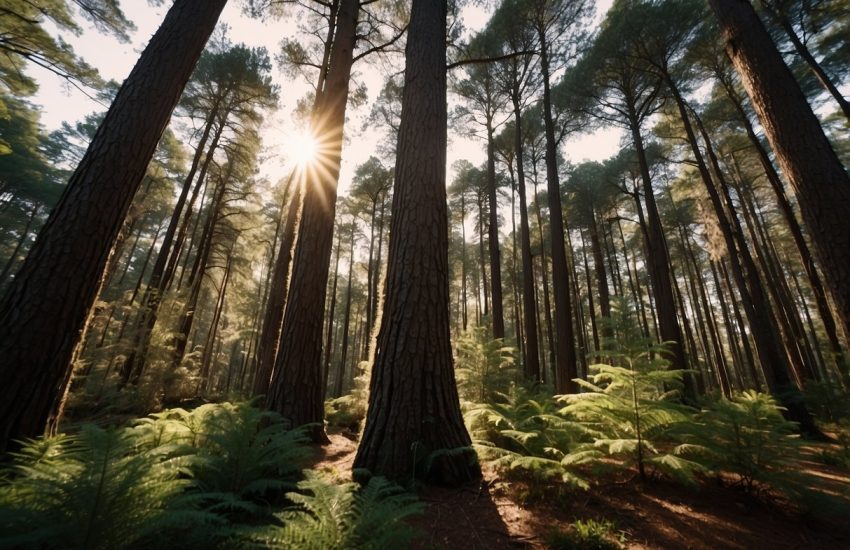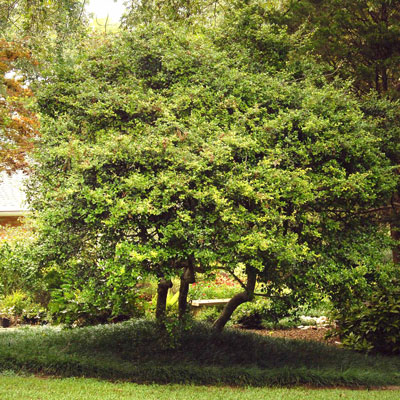8 Evergreen Trees to Plant in Ohio
The Ohio Buckeye tree, which may reach heights of 60 to 80 feet and bears palmate leaves, pale yellow blooms, and dark brown buckeye nuts, is Ohio's official tree. More than 750,000 acres of Ohio are covered in dark brown silt loam, which has excellent drainage. This soil is utilized to grow corn and soybeans since it is so productive. Trees and shrubs can be grown well there as well.
Natives of Ohio live in homes surrounded by some of the most breathtaking scenery in the country. Ohio residential landscapes are a delight to behold because of a combination of native trees, substantial shade trees, and vibrant shrubs.
Best Evergreen Trees to Grow in Ohio
Because they provide year-round color and privacy and soften hardscapes, evergreen trees are fantastic for house landscapes. They look excellent either by themselves or when layered with other plants. The growth rate of a tree is one of the characteristics that homeowners most frequently seek.
You can easily ensure that your garden is colorful all year long by adding a few evergreen trees to your design. Fast-growing evergreens, however, maybe the best option if you need to quickly fill a vast space in your yard without going over budget for a giant tree. In just a year or two, they can significantly alter your landscape. Since the ground is typically frozen in the winter and too hot in the summer, spring or early fall are the ideal times to plant these evergreen trees in your yard.
1. White Fir
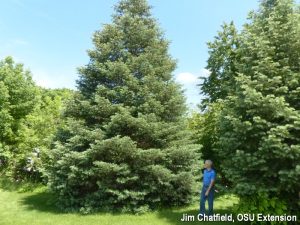
Concolor fir is another name for white fir (Abies concolor). The tree reaches heights of 50 to 100 feet and a width of 20 to 30 feet. It produces brown pine cones that are 4 to 5 inches long as well as bluish needles that are 2 to 3 inches long. Put the white fir in soil that is well-drained and gets full sun.
2. Yellow Cypress
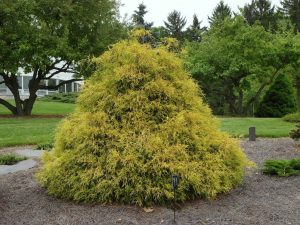
The yellow cypress, Chamaecyparis nootkatensis, is called the Alaska-cedar and the Nootka fake cypress. The tree has gray-green needles and can reach heights of 30 to 45 feet. Its brown pine cones mature in two years. Plant yellow cypress in deep, wet soil that receives plenty of sun.
3. Norway Spruce
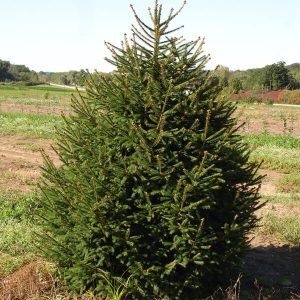
The Norway spruce has a 20-foot spread and a height range of 80 to 150 feet. The tree produces male and female cones with green or blue-green needles that can reach an inch in length. The seeds are produced by the 4 to 6-inch long, reddish-brown female cones. The males are smaller and resemble clusters of tiny, delicate flowers hanging from the tree. The Norway spruce should be planted in moist soil in full sun.
4. Scotch Pine
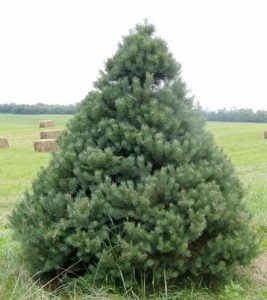
The Scotch pine reaches heights of 30 to 50 feet, has blue-green needles 1-12 to 4 inches long, and can endure up to three years. The 1 to 3-inch-long cones have a drab brown tint. The Scotch pine should be planted in well-drained soil with whole light.
5. Eastern Hemlock
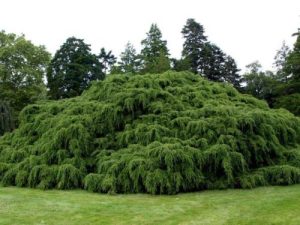
Canada hemlock is another name for eastern hemlock. The tree can reach a height of 60 to 165 feet and produces flat needles that can get as long as 1/2 inch. The tree begins to produce cones between the ages of 20 and 30, takes 200 to 300 years to achieve maturity, and has a lifespan of up to 1,000 years. Eastern hemlock should be planted in shady areas with moist soil that is never allowed to dry out. A young tree will die in the whole light.
6. Northern White Cedar
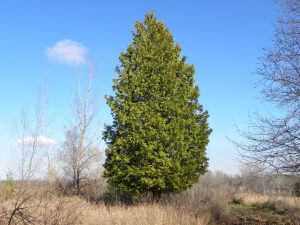
Arborvitae and Eastern arborvitae are different names for Northern white cedar. The tree has a height range of 30 to 60 feet and its dark-green foliage changes to yellow-green in the fall. In April, yellow, green, or brown flowers begin to bloom, and then red or brown pine cones follow. Plant the Northern White Cedar in dry to moist soil, in the sun, in partial shade, or in full shade.
7. Green Giant Arborvitae
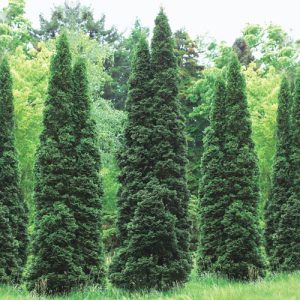
The green giant arborvitae is an enormous, active, and quickly expanding evergreen. It has dense, lush green foliage with a pyramidal to a conical natural shape, which darkens or bronzes a little in the winter. This is a superb landscape tree that may be used as a screen, a hedge, or even as a single specimen. It is a fantastic option for a natural windbreak since, once developed, it resists wind and can sustain heavy ice or snow.
8. Murray Cypress
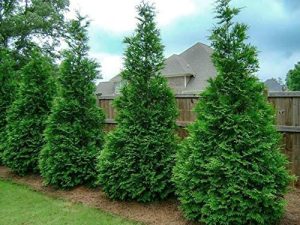
The Murray Cypress, one of the eight evergreen trees on this list with the quickest growth rates, may expand by up to 4 feet annually. It stands between 30 and 40 feet tall at its full, mature height. The tree's base and most comprehensive point are around 10 feet apart.
Even in the poorest soils, these trees survive in harsh colds and heat. It also has robust roots. This tree can survive wind and storms once it has grown. To put it briefly, the Murray Cypress is a robust and resilient tree. These trees grow well as a privacy hedge when planted next to each other.
How to Keep Evergreen Trees Healthy
Your trees will grow more quickly if they are in good health. Plant evergreen conifers can get at least six to eight hours of direct sunlight daily because most need full sun. During their first year, newly planted trees will require regular watering. A covering of mulch will assist them in maintaining constant soil moisture during dry spells.
Use Vigoro Evergreen Fertilizer, a slow-release granular fertilizer explicitly made for evergreens, to feed your trees in the early spring. Water evergreens thoroughly in cold climates before the soil freezes in the late fall or winter. Evergreens never truly hibernate, so their roots still extract the water to fend off the arid winter winds.
Expect your evergreens to take a while to grow, but if you provide them with the right conditions, most of these kinds should increase in height by at least a foot annually. Even fast-growing evergreens will eventually begin to develop to their full potential, so if you leave them in your yard for a long time, you'll notice that their development gradually slows down. You can also cut your trees back each year if they grow to a comfortable height but then keep getting taller and broader.
Which trees are evergreen?
You might be wondering what evergreen trees are. An outdoor tree that retains its leaves all year and into the following growth season is known as an evergreen. In a technical sense, both evergreen conifers and tropical evergreen trees are evergreens. Some of the evergreens for sale are commonplace, while others might surprise you:
● Austrian Pine: This common but beautiful evergreen tree. The Austrian Pine is famous among many due to its dense privacy screen and sound-absorbing abilities. This tree is simple to maintain because it can grow in a wide range of climates (zones 3–8) and is highly adaptable.
● Little Gem Magnolia Tree: This unusual and thriving tree might be different from what you expected. This tree thrives in warm and tropical climates, making it ideal for those growing in zones 7 through 10. This majestic tree blooms beautifully in the fall.
Conclusion
A class of trees known as evergreens is recognized by botany. They stand out because the plant's foliage is year-round green and active, especially in the winter. They, therefore, have many growing seasons.
When most people think of evergreen trees, only pine and other conifers come to mind. However, many different kinds of evergreen trees can be found worldwide.
Evergreen trees retain their foliage all year long. Evergreen trees are beneficial in gardens for several reasons, including ornamental value and privacy in the garden. Evergreens are especially suitable for screening trees since their leaf and shape remain attractive throughout the year.

